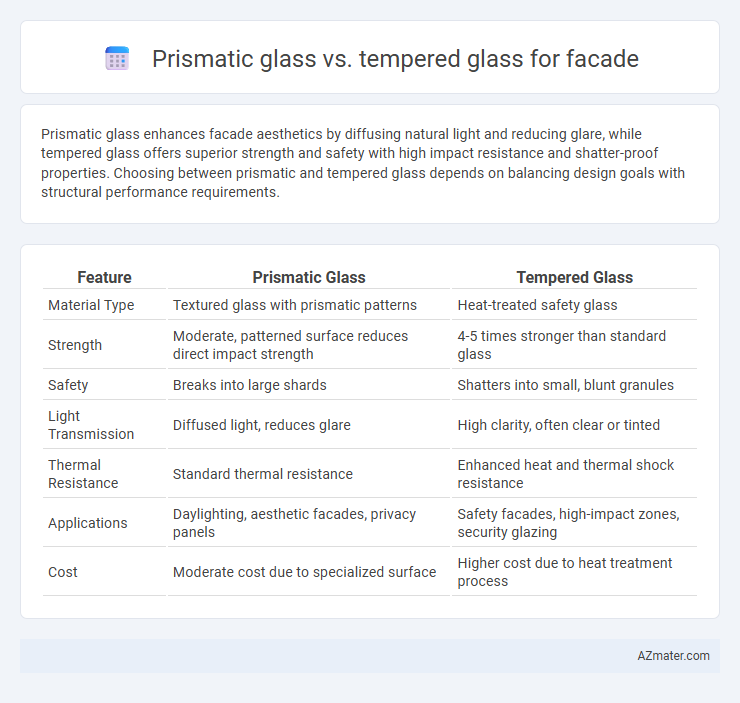Prismatic glass enhances facade aesthetics by diffusing natural light and reducing glare, while tempered glass offers superior strength and safety with high impact resistance and shatter-proof properties. Choosing between prismatic and tempered glass depends on balancing design goals with structural performance requirements.
Table of Comparison
| Feature | Prismatic Glass | Tempered Glass |
|---|---|---|
| Material Type | Textured glass with prismatic patterns | Heat-treated safety glass |
| Strength | Moderate, patterned surface reduces direct impact strength | 4-5 times stronger than standard glass |
| Safety | Breaks into large shards | Shatters into small, blunt granules |
| Light Transmission | Diffused light, reduces glare | High clarity, often clear or tinted |
| Thermal Resistance | Standard thermal resistance | Enhanced heat and thermal shock resistance |
| Applications | Daylighting, aesthetic facades, privacy panels | Safety facades, high-impact zones, security glazing |
| Cost | Moderate cost due to specialized surface | Higher cost due to heat treatment process |
Introduction to Prismatic and Tempered Glass Facades
Prismatic glass facades utilize micro-structured surfaces to direct and diffuse natural light, enhancing daylight penetration while reducing glare and solar heat gain. Tempered glass facades provide enhanced strength and safety by undergoing a heat treatment process that increases resistance to impact and thermal stress. Both prismatic and tempered glass contribute to energy-efficient building designs, with prismatic glass optimizing light distribution and tempered glass ensuring durability and occupant protection.
Key Differences Between Prismatic and Tempered Glass
Prismatic glass features a patterned surface designed to refract and distribute natural light evenly, enhancing daylighting and reducing glare in building facades, while tempered glass is heat-treated for superior strength and safety, resisting impact and thermal stress. Prismatic glass primarily improves optical performance and energy efficiency by redirecting sunlight, whereas tempered glass strengthens structural integrity and meets safety standards in high-rise applications. The choice between prismatic and tempered glass depends on balancing light management with durability requirements in facade design.
Optical Properties and Light Diffusion
Prismatic glass enhances facade performance by directing and diffusing natural light, reducing glare and improving daylight distribution through its micro-structured surface. Tempered glass offers high strength and safety but generally provides uniform transparency without significant light diffusion, resulting in more direct light transmission. Choosing prismatic glass optimizes optical properties for energy efficiency and visual comfort, while tempered glass prioritizes durability and safety.
Strength and Safety Considerations
Tempered glass offers superior strength compared to prismatic glass, with its enhanced resistance to impact and thermal stress making it ideal for facade applications requiring heightened safety. Prismatic glass, while providing unique light diffusion and aesthetic benefits, typically lacks the same structural toughness and shatter-resistance inherent in tempered glass. Safety standards often favor tempered glass in facades due to its ability to break into small, less harmful pieces upon impact, significantly reducing injury risks.
Energy Efficiency and Thermal Performance
Prismatic glass enhances facade energy efficiency by diffusing natural light deeper into building interiors, reducing reliance on artificial lighting and lowering cooling loads. Tempered glass offers superior thermal performance through increased strength and thermal resistance, minimizing heat transfer and enhancing insulation. Combining prismatic patterns with tempered glass can optimize daylight utilization while maintaining robust thermal barriers in facade design.
Aesthetic and Design Flexibility
Prismatic glass offers unique aesthetic qualities by refracting light to create dynamic visual effects and enhanced natural illumination for facades, making it ideal for innovative architectural designs. Tempered glass provides a sleek, clear appearance with high strength and safety features, allowing for large, uninterrupted spans and versatile design applications. Combining prismatic and tempered glass can maximize both artistic expression and structural integrity in facade projects.
Maintenance and Durability
Prismatic glass offers enhanced light diffusion and reduces glare, but requires specialized cleaning to maintain its optical performance, making routine maintenance more intricate compared to tempered glass. Tempered glass boasts superior strength and impact resistance, enhancing durability against environmental stress and reducing the risk of breakage over time. Both options provide safety benefits, but tempered glass is generally favored for facade applications where long-term durability and straightforward maintenance are critical.
Cost Comparison and Budget Considerations
Prismatic glass typically costs 20-30% more than tempered glass due to its advanced light-diffusing technology and manufacturing complexity, impacting initial facade project budgets. Tempered glass offers a more affordable option with standard safety features, making it preferable for cost-sensitive projects while delivering durability and impact resistance. Budget considerations must weigh the long-term energy savings and aesthetic benefits of prismatic glass against the lower upfront costs and proven performance of tempered glass.
Environmental Impact and Sustainability
Prismatic glass enhances natural daylight penetration, reducing the need for artificial lighting and lowering energy consumption, which positively impacts a building's carbon footprint. Tempered glass offers superior strength and durability, leading to a longer facade lifespan and less frequent replacements, thereby minimizing material waste. Both materials contribute to sustainable building design, but prismatic glass's ability to optimize daylight can significantly improve overall energy efficiency in facades.
Application Suitability: Choosing the Right Glass for Your Facade
Prismatic glass enhances natural daylight distribution, making it ideal for facades in buildings prioritizing energy efficiency and occupant comfort by reducing glare and heat gain. Tempered glass offers superior strength and safety, suitable for high-impact areas and facades exposed to extreme weather conditions or requiring enhanced security. Selecting between prismatic and tempered glass hinges on balancing daylight control with structural durability based on specific facade performance requirements.

Infographic: Prismatic glass vs Tempered glass for Facade
 azmater.com
azmater.com